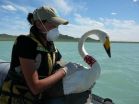(Press-News.org) UT Arlington biochemists say their newly published study brings researchers a step closer to understanding how the commonly used synthetic compound bisphenol-A, or BPA, may promote breast cancer growth.
Subhrangsu Mandal, associate professor of chemistry/biochemistry, and Arunoday Bhan, a PhD student in Mandal's lab, looked at a molecule called RNA HOTAIR. HOTAIR is an abbreviation for long, non-coding RNA, a part of DNA in humans and other vertebrates. HOTAIR does not produce a protein on its own but, when it is being expressed or functioning, it can suppress genes that would normally slow tumor growth or cause cancer cell death.
High levels of HOTAIR expression have been linked to breast tumors, pancreatic and colorectal cancers, sarcoma and others.
UT Arlington researchers found that when breast cancer and mammary gland cells were exposed to BPA in lab tests, the BPA worked together with naturally present molecules, including estrogen, to create abnormal amounts of HOTAIR expression. Their results were published online in February by the Journal of Steroid Biochemistry and Molecular Biology.
"We can't immediately say BPA causes cancer growth, but it could well contribute because it is disrupting the genes that defend against that growth," said Mandal, who is corresponding author on the paper.
"Understanding the developmental impact of these synthetic hormones is an important way to protect ourselves and could be important for treatment," he said.
Bhan is lead author on the new paper. Co-authors include Mandal lab members Imran Hussain and Khairul I Ansari, as well as Linda I. Perrotti, a UT Arlington psychology assistant professor, and Samara A.M. Bobzean, a member of Perrotti's lab.
"We were surprised to find that BPA not only increased HOTAIR in tumor cells but also in normal breast tissue," said Bhan. He said further research is needed, but the results beg the question – are BPA and HOTAIR involved in tumor genesis in addition to tumor growth?
BPA has been widely used in plastics, such as food storage containers, the lining of canned goods and, until recently, baby bottles. It belongs to a class of endocrine disrupting chemicals, or EDCs, which have been shown to mimic natural hormones. These endocrine disruptors interfere with hormone regulation and proper function of human cells, glands and tissue. Previous studies have linked BPA to problems with reproductive development, early puberty, obesity and cancers.
Under normal circumstances, estrogen regulates HOTAIR, turning its expression on and off through interaction with molecules called estrogen-receptors, or ERs, and estrogen receptor-coregulators, or ER-coregulators. The new study found that BPA disrupts the normal function of the ERs and the ER-coregulators when estrogen was present and when it wasn't, potentially implicating it in tumor growth in a variety of cancers.
"Research work is at its best when results can shed light on issues of public concern. Dr. Mandal and his team are using their expertise to do just that. Their findings continue to advance what we know about how the chemicals in our environment could be affecting us in unseen ways," said Pamela Jansma, dean of the UT Arlington College of Science.
Researchers saw similar results when they exposed HOTAIR to a synthetic estrogen called diethylstilbestrol (DES). DES has been shown to increase risks of breast cancer and other health problems in women who used it and their daughters. It was formerly used as a hormone replacement and as an attempt to prevent pregnancy complications.
INFORMATION:
The new paper is called "Bisphenol-A and diethylstilbestrol exposure induces the expression of breast cancer associated long noncoding RNA HOTAIR in vitro and in vivo." It is available here: http://www.sciencedirect.com/science/article/pii/S0960076014000314.
The National Institutes of Health and American Heart Association funded Mandal's research into endocrine disrupting chemicals.
The University of Texas at Arlington is a comprehensive research institution and the second largest institution in The University of Texas System. The Chronicle of Higher Education ranked UT Arlington as the seventh fastest-growing public research university in 2013. U.S. News & World Report ranks UT Arlington fifth in the nation for undergraduate diversity. Visit http://www.uta.edu to learn more and follow #UTAdna
UT Arlington study links BPA and breast cancer tumor growth
2014-03-06
ELSE PRESS RELEASES FROM THIS DATE:
NASA's TRMM satellite images show California soaker moved eastward
2014-03-06
The Tropical Rainfall Measuring Mission or TRMM satellite provided a look at the rainfall associated with the large storm system that brought soaking rains to California on Feb. 28 and Mar. 1. Satellite imagery created at NASA shows the movement of the storm from the U.S. West Coast to the East Coast.
At NASA's Goddard Space Flight Center in Greenbelt, Md. images were created using data from the TRMM Microwave Imager (TMI) instrument that showed the movement of recent stormy weather from California's Pacific Ocean coast to the Atlantic Coast. TRMM is a satellite managed ...
NASA's THEMIS discovers new process that protects Earth from space weather
2014-03-06
In the giant system that connects Earth to the sun, one key event happens over and over: solar material streams toward Earth and the giant magnetic bubble around Earth, the magnetosphere helps keep it at bay. The parameters, however, change: The particles streaming in could be from the constant solar wind, or perhaps from a giant cloud erupting off the sun called a coronal mass ejection, or CME. Sometimes the configuration is such that the magnetosphere blocks almost all the material, other times the connection is long and strong, allowing much material in. Understanding ...
Crystals ripple in response to light
2014-03-06
Light can trigger coordinated, wavelike motions of atoms in atom-thin layers of crystal, scientists have shown. The waves, called phonon polaritons, are far shorter than light waves and can be "tuned" to particular frequencies and amplitudes by varying the number of layers of crystal, they report in the early online edition of Science March 7.
These properties - observed in this class of material for the first time - open the possibility of using polaritons to convey information in tight spaces, create images at far finer resolution than is possible with light, and manage ...
Plasma plumes help shield Earth from damaging solar storms
2014-03-06
The Earth's magnetic field, or magnetosphere, stretches from the planet's core out into space, where it meets the solar wind, a stream of charged particles emitted by the sun. For the most part, the magnetosphere acts as a shield to protect the Earth from this high-energy solar activity.
But when this field comes into contact with the sun's magnetic field — a process called "magnetic reconnection" — powerful electrical currents from the sun can stream into Earth's atmosphere, whipping up geomagnetic storms and space weather phenomena that can affect high-altitude aircraft, ...
Researchers calculate how river networks move across a landscape
2014-03-06
Large river networks — such as those that funnel into the Colorado and Mississippi rivers — may seem to be permanent features of a landscape. In fact, many rivers define political boundaries that have been in place for centuries.
But scientists have long suspected that river networks are not as static as they may appear, and have gathered geologic and biological evidence that suggest many rivers have been "rewired," shifting and moving across a landscape over millions of years.
Now researchers at MIT and the Swiss Federal Institute of Technology (ETH Zurich) have developed ...
Warmer temperatures push malaria to higher elevations
2014-03-06
Researchers have debated for more than two decades the likely impacts, if any, of global warming on the worldwide incidence of malaria, a mosquito-borne disease that infects more than 300 million people each year.
Now, researchers from the London School of Hygiene & Tropical Medicine and the University of Michigan, with colleagues, are reporting the first hard evidence that malaria does—as had long been predicted—creep to higher elevations during warmer years and back down to lower altitudes when temperatures cool.
The study, due to be published in Science and based ...
Scientists create detailed picture of protein linked to learning, pain and brain disorders
2014-03-06
LA JOLLA, CA, and NASHVILLE, TN – March 6, 2014 – Researchers at The Scripps Research Institute (TSRI) and Vanderbilt University have created the most detailed 3-D picture yet of a membrane protein that is linked to learning, memory, anxiety, pain and brain disorders such as schizophrenia, Parkinson's, Alzheimer's and autism.
"This receptor family is an exciting new target for future medicines for treatment of brain disorders," said P. Jeffrey Conn, PhD, Lee E. Limbird Professor of Pharmacology and director of the Vanderbilt Center for Neuroscience Drug Discovery, who ...
Warmer temperatures fuel spread of malaria into higher elevations
2014-03-06
In the tropical highlands of South America and East Africa, cool temperatures have historically kept mosquito-borne diseases, such as malaria, at bay. New research by Howard Hughes Medical Institute (HHMI) scientists shows that as annual temperatures rise in these areas, malaria can spread to populations in higher elevations that had historically not been at as much risk of being infected by malaria parasites.
HHMI scientists have compared the yearly distribution of malaria cases in two mountainous regions in South America and East Africa, and found that in warmer years, ...
Birds of all feathers and global flu diversity
2014-03-06
A group of international scientists have completed the first global inventory of flu strains in birds by reviewing more than 50 published studies and genetic data, providing new insight into the drivers of viral diversity and the emergence of disease that can ultimately impact human health and livelihoods.
The research, published in the journal PLOS ONE and performed as part of the USAID PREDICT project, identified over 116 avian flu strains in wild birds. This is roughly twice the number that were found in domestic birds, and more than ten times the number found in humans. ...
Returning vets face 'warring identities' distress
2014-03-06
PROVIDENCE, R.I. [Brown University] — Much of the research on post-combat mental health of veterans focuses on problems like post-traumatic stress disorder (PTSD) and major depression. A paper co-authored by R. Tyson Smith, visiting assistant professor of sociology, takes an even broader snapshot of returning soldiers' mental state by focusing instead on the identity conflict many face when transitioning from soldier to civilian life and how that conflict manifests as mental distress. The paper was published in the January issue of Society and Mental Health.
"You can't ...





